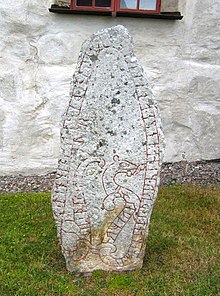Runestone from Yttergärde
The rune stone of Yttergärde ( U 344 or "Orkestasten") is one of the so-called "England rune stones" because it mentions the Viking trains to there. It stands next to Orkesta Church in Vallentuna parish in Uppland in Sweden . The rune stone made of white granite is dated to around 1020 AD. Richard Dybeck (1811–1877), the poet of the Swedish national anthem and archaeologist, found the runestone in 1868.
The runic scraper Åsmund Kåresson wrote:
in ulfr hafiR o || onklati 'þru kialt || takat þit uas fursta þis tusti ka-t' þ (a) ---- (þ) urktil 'þa cold knutr .
Translated: “But Ulv has received three monies ( tributes ) in England . That was the first thing Toste paid. Then Torkel paid. Then Knut paid ”. So that the stone is one of the most significant of the 30 England rune stones ( Swedish Englandsstenarna ).
The text lacks the dedication formula typical of the time. It is a monument originally made of two stones. The dedication formula was written on the stone (U 343) that was lost in the 18th century. His inscription comes from a drawing by Johan Peringskiöld (1654–1720): “Karse and [Karlbjö] rn had this stone built in memory of Ulv, their father. God help his [soul] and God's mother. "
The text of the rune stone U 344 is in the serpent band with an Irish belt and is incised to the left, only the last three words and the name Knutr outside the queue are written to the right with reversible runes. Since the inscription uses the o-rune and there are no dotted runes, it can be dated to the first half of the 11th century. The historically verifiable content of the text enables an even more precise determination.
During the Viking Age (800-1050 AD), from 990 onwards, Danish kings attacked England with their large armies and warriors from all Nordic countries. Since the country was devastated and looted, the English tried to buy peace by paying so-called Danegelder . In 991 almost 4000 kg of silver were paid, in 994 it was around 6000 kg, 1002 almost 9000 kg, 1007 around 30,000 kg and 1012 just under 18,000 kg. In 1016 the Viking campaigns ceased to affect England because the Danish King Canute had conquered the country. In 1018 Knut paid his auxiliary troops a wage of over 30,000 kg of silver, the highest and last Danegeld. The "Knut" mentioned on the Yttergärde stone is consequently the king of Denmark and England .
The second named Viking leader was probably "Torkel the High", the chief of the Jomswikings , who was involved in Viking campaigns between 1009 and 1012. The Yomswikings were a mercenary union of different ethnicities.
In contrast to Torkel and Knut, Toste, who paid Ulv's first Danegeld, is not mentioned in the Anglo-Saxon chronicle. He is probably the Swedish Viking leader that Snorri Sturluson mentions in Heimskringla : “Toste was the name of a man in Sweden, one of the most powerful and respected men in that country who had no title of rank. He was a very great warrior and spent a long time on campaigns overseas. He was called Sköglar-Toste (Valkyren- or Schlachten-Toste). ”Toste was the father of Sigrid Storråda , who is said to have been married to the Danish King Sven Gabelbart and the Swedish King Erik Segersäll (d. 995). The Anglo-Saxon chronicle does not mention him, but for 991 Olav I. Tryggvason , Gudmund and Justin are named as Viking leaders. Today it is assumed that the name Justin is a mistake in the tradition, it should actually be called Tusti. Toste is also likely to have been involved in later Viking campaigns as commander of Sven Gabelbart's Swedish auxiliary troops in 1003. It is therefore obvious that Ulv from Borresta went on a viking trip between 1003 and 1016 in the service of the Swedish chief Toste .
Ulv also appeared as a rune master : a stone from Orkesta (U 336), from Lundby (U328) and two stones from Risbyle (U 160 and U 161) are ascribed to him, one of the Risbyle stones even bears his signature.
See also
literature
- Klaus Düwel: Runic lore . 3. Edition. Verlag JB Metzler, Stuttgart, Weimar 2001.
- Lars Magnar Enoksen: Runor - Historia, Tydning, Tolkning . Historiska Media, Lund 1998.
- Mats G. Larsson: Tre gälder i England: i vikingars kölvatten över Nordsjön 2008
Individual evidence
- ↑ Rune, the lettering of which is designed against the direction of the writing
Web links
- Runestone from Yttergärde - entry in the database "Fornsök" des Riksantikvarieämbetet (Swedish)
- description
Coordinates: 59 ° 36 ′ 16.9 ″ N , 18 ° 6 ′ 36.3 ″ E
